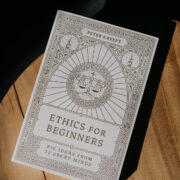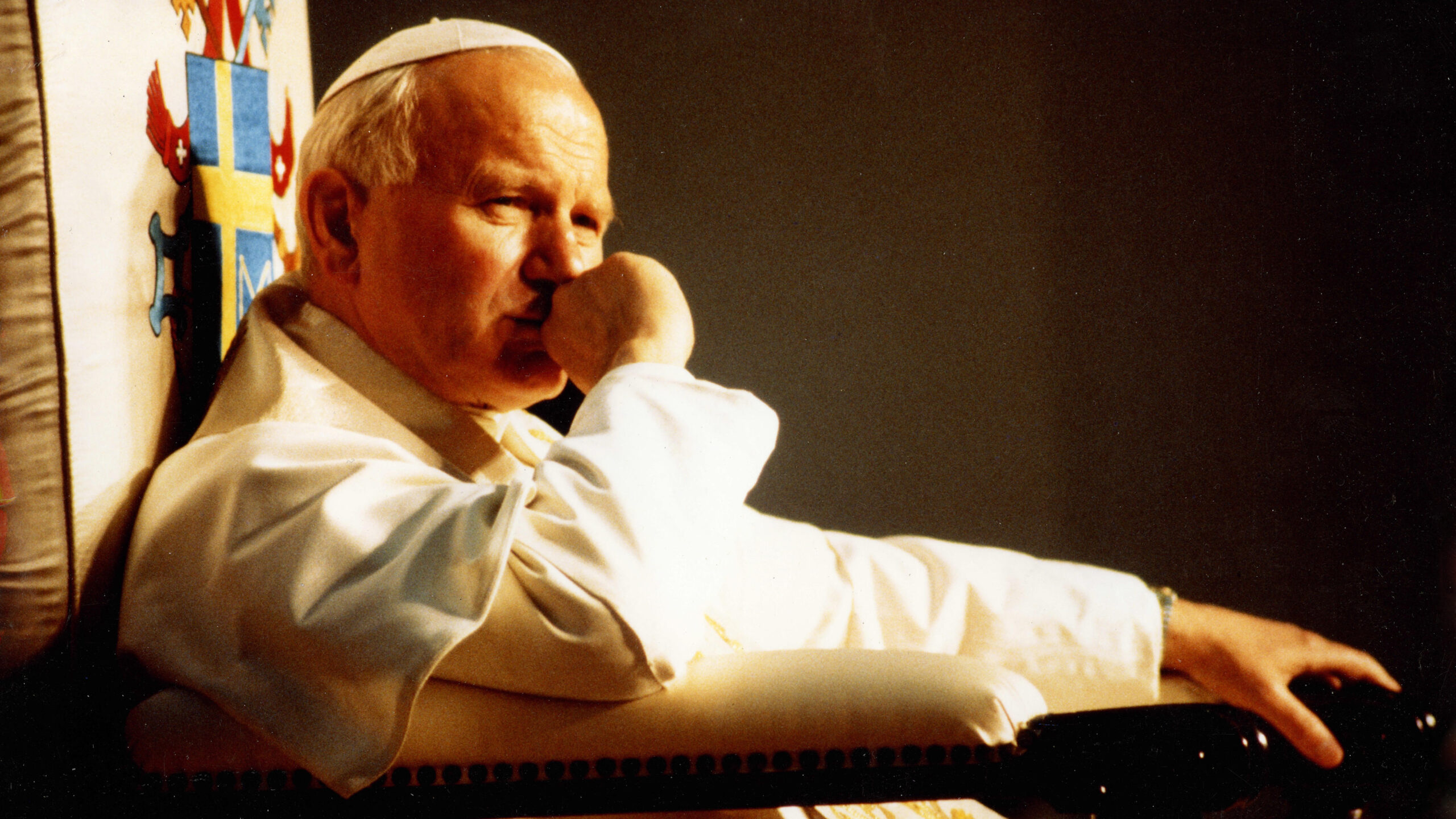The following article is sourced from the forthcoming Spring 2023 issue of Evangelization & Culture, the Word on Fire Institute’s quarterly print journal. To learn more and receive your own print issues, start your membership here.
Imagine yourself as a twenty-year-old Polish worker living in a dingy apartment in Dębniki, a working-class neighborhood of Kraków, in early 1941. After a brilliant beginning to your university career, your higher studies have been abruptly ended by the brutal Nazi occupation that followed the dismemberment of your country in September 1939 by two totalitarian powers. You’ve spent a year and a half at back-breaking manual labor, scratching out a living for yourself and your widower father, who has already lost one child, your beloved older brother. You live in a violent, lawless environment—“Gestapoland,” as one historian would later dub it—where the question posed to you every day is not “Will I be alive on my next birthday?” but “Will I be alive tomorrow?”
You come home one wintry night and find your father dead in his bed. Kneeling in prayer beside his mortal remains, you later recall, was an experience of the most profound solitude, even abandonment: “I never felt so alone.” Three and a half more years of life under Nazi awfulness lie before you, during which you will be struck down by a German military truck and left for dead in a ditch, only to be rescued by a passerby; and more of your friends will die, including Jews murdered in the Holocaust. By the end of the war, 20 percent of your countrymen who were alive in 1939 will be dead. You ask yourself, time and again, “So many young people of my own age are losing their lives; why not me?”
Decades later, asked to sum up your life during World War II in Nazi-occupied Kraków, you will answer in one sentence: “I participated in the great experience of my contemporaries—humiliation at the hands of evil.”
That experience, which Karol Wojtyła shared with millions of other Poles, was a vast pressure cooker, and life under that kind of pressure had different effects on different people. Some went mad. Others committed suicide, unable to face any longer the acute existential strain of daily life in Gestapoland. Still others got involved in various forms of resistance: armed resistance in Poland’s vast forests, or in the Warsaw Ghetto Uprising of 1943 and the Warsaw Uprising of 1944; cultural resistance to the occupier in various schemes to keep the memory of “Poland” alive, like the Rhapsodic Theater that Wojtyła helped create. Most, perhaps, simply tried to survive.
The pressures at work in dismembered and occupied Poland from September 1939 until mid-1945 can be compared to the fiery geological forces at work beneath the crust of the Earth. When those forces reach a certain combustibility or break through the surface of our planet, they can cause enormous damage through earthquakes, volcanic explosions, and tsunamis. But something else forms under those fierce pressures: diamonds, the hardest, brightest substance known to our science; diamonds that, in industrial use, can cut through what seems otherwise impermeable; diamonds that, as jewelry, can reflect light in a uniquely brilliant way.

Under ferocious pressure during the Second World War, Karol Wojtyła, whom the world would know much better as Pope John Paul II, became a kind of human diamond: able to cut though what seemed impossible to pierce, much less shatter (like the Berlin Wall); able to reflect the light of divine grace in a singular way (as John Paul would do for human beings in a virtual infinity of cultural circumstances). The experience of the war, and the suffering Wojtyła endured during it, produced the greatest Catholic evangelist of modern times—because that suffering was understood, internalized, and transformed through the prism of a cruciform Christian faith.
So when John Paul II came to write his 1984 apostolic letter Salvifici Doloris (Redemptive Suffering), he wrote not only as the impressive philosopher and keen student of the Bible that he was but as a man who knew intense suffering “from inside.” He had suffered personally, and he had helped others bear their suffering. Suffering was not an abstraction for John Paul but a reality of the human condition. Wojtyła had also come to know suffering “from inside” through his extensive experience as a confessor and spiritual director: an innovative priest who once described his pastoral method as the “accompaniment” of another Christian soul in the unveiling of the truth of that other’s life—the truths revealed in the moral choices we make.
In Salvifici Doloris, John Paul II reminds us that suffering is unique to human beings. Dogs, cats, and horses feel pain; only human beings suffer. This means that suffering tells us important things about what it means to be us. Suffering tells us that we are not simply bundles of neurons. At the deepest level of us, we are spiritual beings. We have souls. Suffering is thus one of those human experiences that points us to the extraordinary and numinous that lies just on the far side of the ordinary; suffering can be an experience of transcendence when it reveals the human soul’s capacity for courage, endurance, and self-sacrifice. As John Paul wrote, suffering is “one of those points in which man is in a certain sense ‘destined’ to go beyond himself.”
Yet to ponder suffering this way, however penetrating the insights that may be gained, is to leave the reflection at the level of philosophy, which was never sufficient for John Paul II, teacher of the Church. Thus, Salvifici Doloris also included John Paul’s biblical and theological reflections on suffering in Christian perspective, which aimed in part at sorting out several confusions about why we suffer, why God permits suffering, and how suffering can be redemptive.
“love is . . . the fullest source of the answer to the question of the meaning of suffering.”
The suffering in and of the world reflected the fact of evil in the world, John Paul wrote. Prelapsarian humanity did not suffer; humanity began to suffer when, as John Paul wrote in his Theology of the Body, self-assertion trumped self-gift as Adam and Eve ate of “the tree of the knowledge of good and evil” (Gen. 2:17). But the evil that entered creation did not cancel out the good that God had declared about the created order during the “six days” in which the Creator brought something out of nothing (Gen. 1:1–31). Moreover, Salvifici Doloris teaches, because evil is “a certain lack, limitation, or distortion of good,” human suffering is enmeshed with both good and evil and therefore touches the mystery of human freedom.
The Old Testament sometimes treats suffering as a form of punishment. But that punishment, John Paul insists, is not some form of sadistic divine retribution; rather, it is an opportunity for “rebuilding goodness in the subject who suffers.” Think, for example, of David after the death of his first child, conceived in his adulterous relationship with Bathsheba; that death deepens David’s profound repentance (“I have sinned against the Lord” [2 Sam. 12:13]) and later leads to the birth of Solomon, who will build the temple that houses the glory of God.
The New Testament takes us deeper into the mystery of suffering, for no mere description of suffering and its sometimes life-changing effects for the good could fully address the profound human mystery involved in the fact that we suffer and that our suffering can be even more painful spiritually and psychologically than physically. Nor could reason alone tell us that, as John Paul puts it, “love is . . . the fullest source of the answer to the question of the meaning of suffering.” That required more than an argument. That required a demonstration, which the thrice-holy God gave “in the cross of Jesus Christ,” whose suffering as man and as the only begotten Son of God had an “incomparable depth and intensity.”
The cruciform nature of redemptive Christian suffering was a prominent theme in the theology of the Swiss polymath Hans Urs von Balthasar. And it is not difficult to find Balthasarian insights in Salvifici Doloris. For it was Balthasar who wrote that, in the suffering of Christ, “all the refuse of the world’s sin is [immolated] in the fire of suffering love.” By taking all the world’s dross upon himself on Calvary and offering it to the Father in a perfect act of obedience unto death, the Lord Jesus was effecting the greatest act of redemptive suffering in history.

And when that death is vindicated by Jesus being raised to a new and superabundant form of life, suffering itself is transformed. The Christ who redeems us by his suffering transforms and redeems suffering. The Christ who died for all offers to all a share in the redemption he effected. And in doing so, he offers us the possibility that, by identifying our suffering with his, we too can participate in his redemptive suffering for the world. For the Christian who conforms his suffering to the cruciform suffering of Christ, in the sure knowledge that Easter follows Good Friday, has a share in Christ’s continuing redemption of the world.
Thus suffering is transformed from absurdity to mission. Thus suffering becomes an expression of human freedom, not human bondage. Thus suffering becomes part of the Christian life lived as a vocation.
John Paul II ended Salvifici Doloris with a meditation on the parable of the Good Samaritan. Anyone who “stops beside the suffering of another person” is like the Good Samaritan, whose “stopping does not mean curiosity but availability.” What do we learn from this? We learn that suffering, although a reflection of the world’s fall and humanity’s, can “unleash love in the human person, that unselfish ‘I’ on behalf of other people, especially those that suffer,” when suffering is suffused by cruciform grace. In that way, “the world of human suffering” summons forth “the world of human love.”
The last years of John Paul II’s epic life were a vivid illustration, indeed an embodiment, of the teaching of Salvifici Doloris. By living his own physical suffering in public, he not only summoned up “the world of human love” in the response of affection and compassion he drew. He also encouraged others in their suffering, lifting pain and mental anguish beyond absurdity and into the realm of grace. In doing so, John Paul also lived out the Carmelite vocation he once imagined embracing as a contemplative monk but that he nevertheless continued to pursue spiritually throughout his active ministry as a diocesan priest, bishop, and pope.
For the war years—the crucible in which the human and Christian personality of John Paul II was forged—were also the years when, under the tutelage of the lay mystic Jan Tyranowski, he discovered the cruciform spiritual theology of the great Counter-Reformation Carmelite reformers, St. John of the Cross and St. Teresa of Ávila. From those two Doctors of the Church, he learned that the cross of Christ is the axis around which history and the cosmos turn. On the cross, redemptive suffering took its most radical form—and was then transformed by the Resurrection into the revelation of the truth about the human future, which is not oblivion in a universe frozen in entropy but eternal life beyond the reach of suffering and death.
Meeting the Risen One who was also the Crucified One empowered the first Christians for mission. That encounter continues to do so today. For meeting the Risen One who is also the Crucified One empowers all who embrace the cause of Christ to transform their own suffering—and the suffering of others they embrace in solidarity—into a blessing for the world.
And more than the world. For as St. Paul taught the Corinthians, and us, the suffering of this present age prepares for us “an eternal weight of glory beyond all measure” (2 Cor. 4:17).
